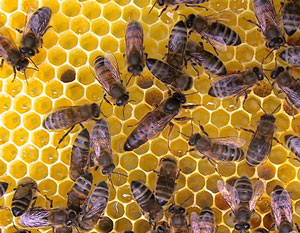
Special to Online Career Tips
Beekeeping is one of my favorite homesteading hobbies. Honeybees pollinate our garden and offer a glimpse into a magical community that works. And then there’s the honey.
Going into winter, I had a sinking feeling that our bees had died. I worried that my hands-off approach (‘they survive just fine in the wild, so I’ll leave them to it’) was a bit too passive. I didn’t know if mites, or worse, colony collapse disorder, may have been to blame. To get to the bottom of it, I asked for help.
Guidance from an experienced teacher helped me realize that the process of rebuilding my beehive was a lot like assembling a buzzing portfolio of clients. With a little planning, I can even have them come right to me.
1. Get good advice
When a friend suggested I ask Tony Jadczak, Maine’s State Apiarist, for advice, I was surprised how close at hand help was. Turns out, a quick phone call is all I needed to tap into a network of resources (in this case, all of them free). Tony said he’d swing by our place the next time he was nearby to inspect our hive. He’s been keeping bees and teaching others how to do it, too, for decades. Not only was he willing to help me get a handle on what went wrong, he happily offered.
2. Lead like a queen
We couldn’t wait to get the call that he was coming. (I put off making firm plans for days, so I’d be available.) When he arrived, Tony unceremoniously pried open the cedar boxes that were sealed up with golden wax. “Your queen died,” he said. “The workers tried to grow a new one, but they were disorganized, and they lost focus.” A queenless colony can’t put away enough honey to feed it through the winter, he said.
With no queen, the lost hive weakens, and then dies. Period.
3. Tend the hive (a bit)
I was expecting my new mentor to tell me that our uncommon hive was ill-sited or for him to prescribe a more involved management plan than I’m down with. I actually like the idea of giving our honeybees a lovely home, flush with nectar-rich plants, and a leg up with occasional feedings in lean times—and not much else. But he didn’t scold me. Our hive is just fine, he said.
And we needn’t change much.
Tuns out, monitoring the hive isn’t daunting at all; I just have to do it regularly. I should pull out a bar or two of honeycomb every month or so to look for healthy bees and uniform comb, he said. If I find several misshapen cells, as in the picture above, I’d know that our queen was failing. Caught early, I could replace the queen and save the hive.
4. Clean up to catch bees
But first, I need new bees. Luring a swarm of honeybees is a choice way to repopulate an old hive. Friends of mine have done it with simple boxes, spiked with pheromones, hung in trees. Building a bait hive was yet another project on our very long list of projects for the past several years.
I couldn’t believe it when Tony said that I didn’t need a bait hive. I had one—using what I already have. Bees will come if I clean and simplify the beehive. His advice was simple:
- Clear out as many dead bees as I can. Extra clutter is distracting—even for bees.
- Leave some healthy, well-formed honeycomb in one box. Bees are drawn to honeycomb: “It just smells ‘right’ to bees,” another beekeeper told me.
- Then wait for the summer swarms. They always come.
Building a rich portfolio career works the same way. Asking for help, following a plan, monitoring progress, and simple housekeeping, are all I need to prepare for new work to fly my way. I just have to remember to use what I’ve already got going for me.
Comments are closed.